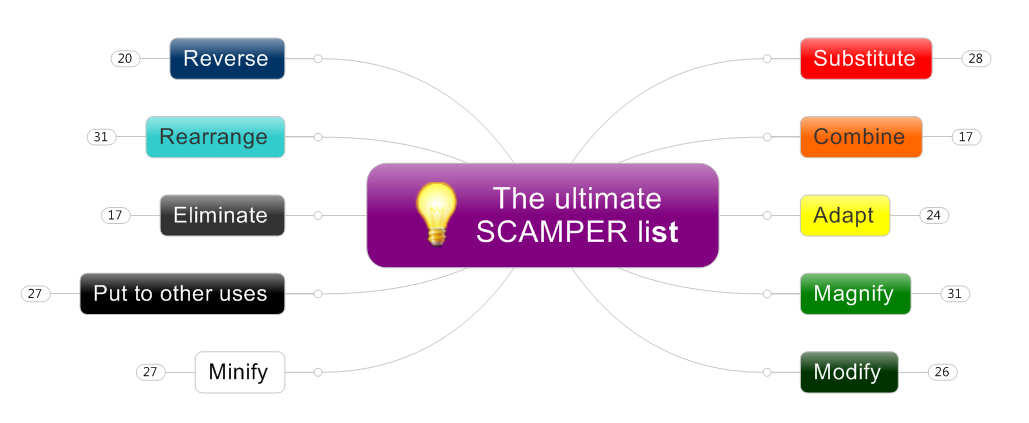“The problem is not the problem. The problem is your attitude about the problem. Do you understand?” – Captain Jack Sparrow
Often, when we’re faced with a challenge, we habitually use a crude form of creative problem-solving – doing a brain dump of any ideas we can think of. For most of us, this approach isn’t very productive or effective.
Why? Because it tends to favor top-of mind-ideas that are of limited value. It also tends to reinforce our confirmation bias – our tendency to favor thoughts and ideas that agree with our preconceived notions about the problem or challenge. Finally, using the same habitual approach over and over is something like digging in a single seam of precious minerals non-stop. Sooner or later, it gets tapped out. Your efforts have a diminishing rate of return. It’s time to explore elsewhere for rich deposits of “idea ore.”
For best results, we need to move beyond these habitual ways of thinking and open our minds to new perspectives, insights and possibilities. Here are 5 powerful ways to do that:
1. Adapt an idea
 Creative thinkers realize that they don’t need to brainstorm something that is totally new to the world. Often, someone in another industry or profession has already solved a similar problem, often quite elegantly and simply. All we need to do is be inspired by them and adapt them to our needs. Here are four steps to use this technique:
Creative thinkers realize that they don’t need to brainstorm something that is totally new to the world. Often, someone in another industry or profession has already solved a similar problem, often quite elegantly and simply. All we need to do is be inspired by them and adapt them to our needs. Here are four steps to use this technique:
- Look for industries, markets or professions similar to yours.
- Conduct a Google search of your problem or challenge, with an emphasis on web pages that describe how others have solved challenges similar to yours.
- Interview experts in that field about their solutions.
- Ask yourself insight-producing questions, like these: What else is like this? What other ideas does it suggest? What idea could I incorporate? What other process could be adapted? What else could be adapted? What ideas outside my field can I incorporate?
For more details on this simple but powerful process, read my article about it here.
2. Cultivate an “insight outlook”
One key to be more creative is to cultivate mindfulness — the habit of looking more deeply at everything you experience with an open, inquisitive spirit. I call that growing your “insight outlook.” Creative people are intensely observant. They know that ideas and inspiration can strike any time, anywhere. So they pay careful attention to everything they think and hear, open-minded about what it may mean to them.
3. SCAMPER around your challenge
During the last several decades, one of the most widely used and successful brainstorming techniques ever has been SCAMPER. Its name is a mnemonic for Substitute, Combine, Adapt, Modify/Magnify/Minify, Put to other uses, Eliminate and Reverse/Rearrange. It’s powerful because it forces you to look at creative challenges from a variety of perspectives. In the process, it helps you explore some fresh pathways of thinking.
Click here to read my blog post on how to use SCAMPER.
4. Use a creative problem solving technique
 As humans, when we need to be truly creative, we often need help side-stepping our beliefs, values and experiences. Fortunately, some incredibly smart people have developed ideation techniques that can help you whack your thinking in new directions. Here are some great resources to help you get started:
As humans, when we need to be truly creative, we often need help side-stepping our beliefs, values and experiences. Fortunately, some incredibly smart people have developed ideation techniques that can help you whack your thinking in new directions. Here are some great resources to help you get started:
The 7 all-time greatest ideation techniques
Use serendipity to your advantage
10 ways to see “hidden” opportunities
5. Use a brainstorming tool
 Brainstorming tools, which include card decks, apps and software, present your muse with evocative words, pictures and other stimuli to jump-start your thinking in new directions. Here are several examples:
Brainstorming tools, which include card decks, apps and software, present your muse with evocative words, pictures and other stimuli to jump-start your thinking in new directions. Here are several examples:
Clarity Cards help you benefit from reflective thinking
The Zig Zag creativity card deck: A brilliant ideation tool
16 powerful ways to brainstorm with mind maps
Brainsparker: An indispensable brainstorming app
Think smarter. Think different.
The next time you’re faced with a creative challenge, don’t just think as hard as you can to generate ideas and solutions. Think smarter. Think different. Think divergently with these tools and techniques. Become a student of creative problem solving tools, techniques and mindsets.
Émile Auguste Chartier, a notable French essayist and philosopher, once said, “Nothing is more dangerous than an idea, when it’s the only one we have.”
Don’t stop with one or two ideas that you’ve brainstormed via brute force thinking.
Use one or more of these tools and techniques to generate a bigger variety of higher-value ideas, from the mundane to the zany. When you have more ideas to choose from, you have more possibilities, more options and more opportunities!
Learn how to convert Evernote into a powerful idea machine in my popular book, Eureka! How to Use Evernote to Generate, Incubate, Evaluate & Activate Your Best Ideas


